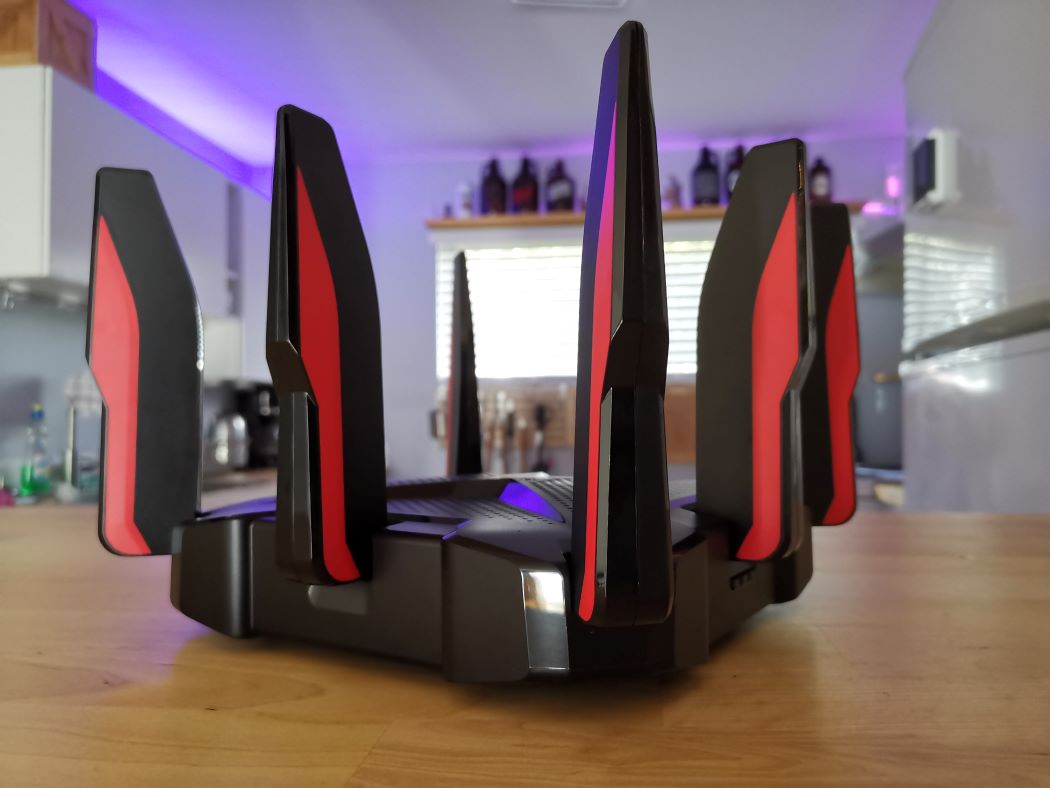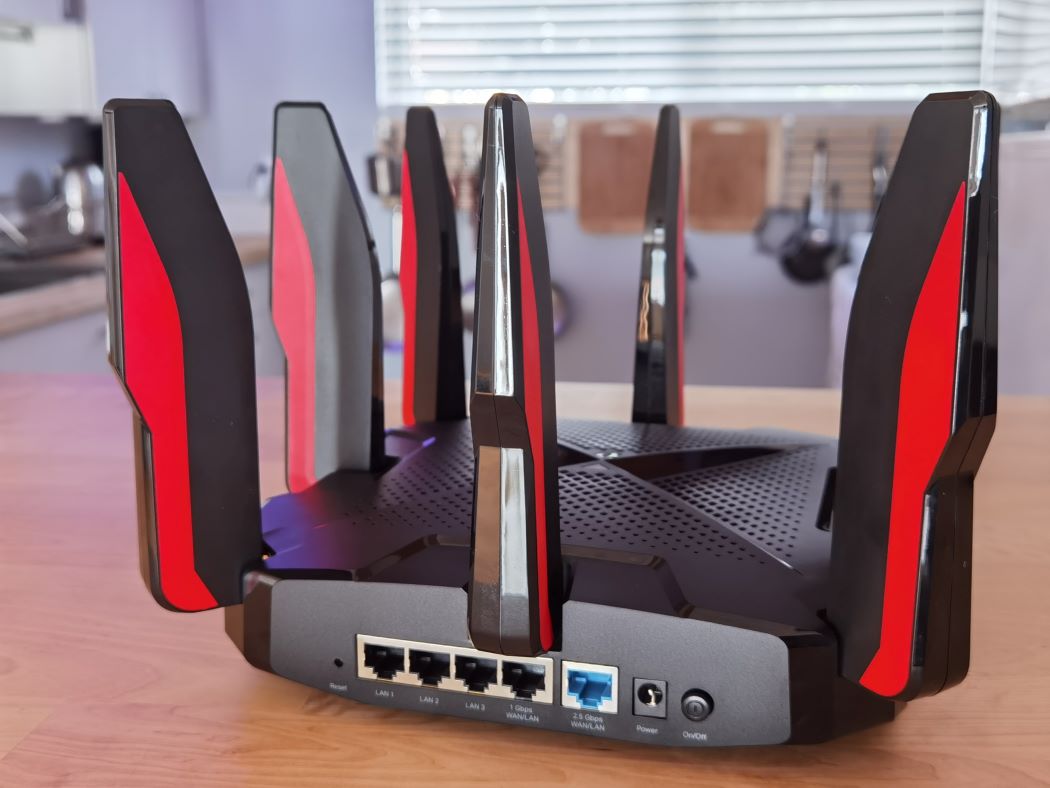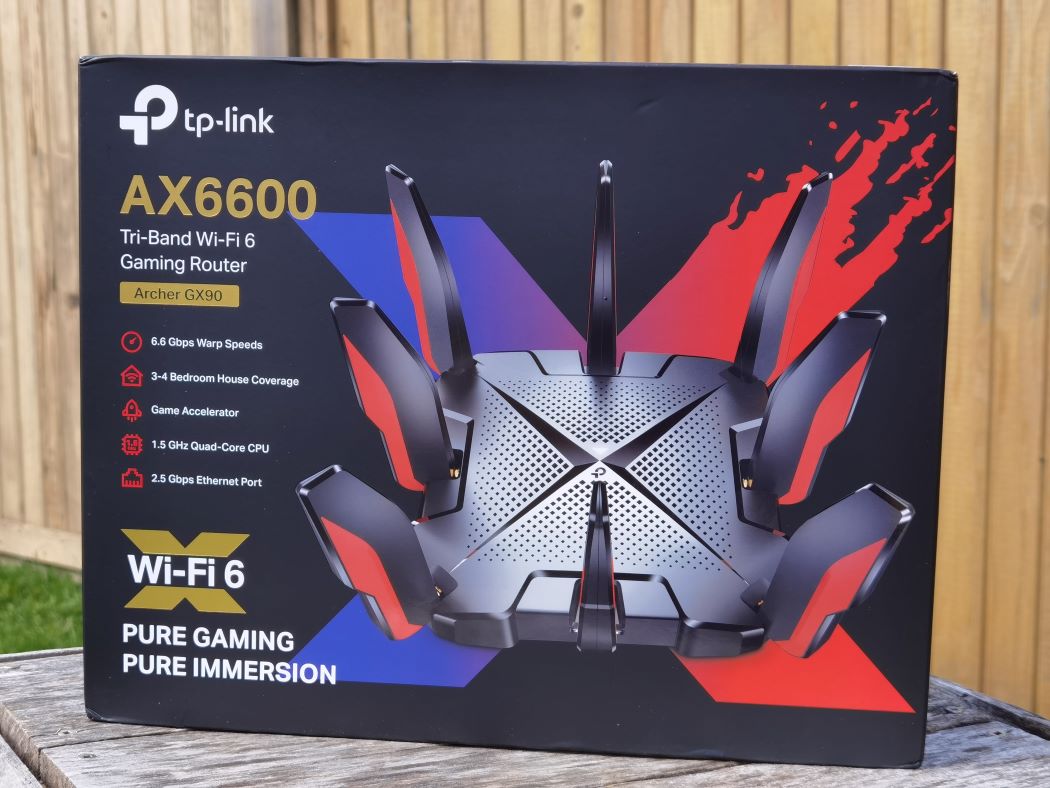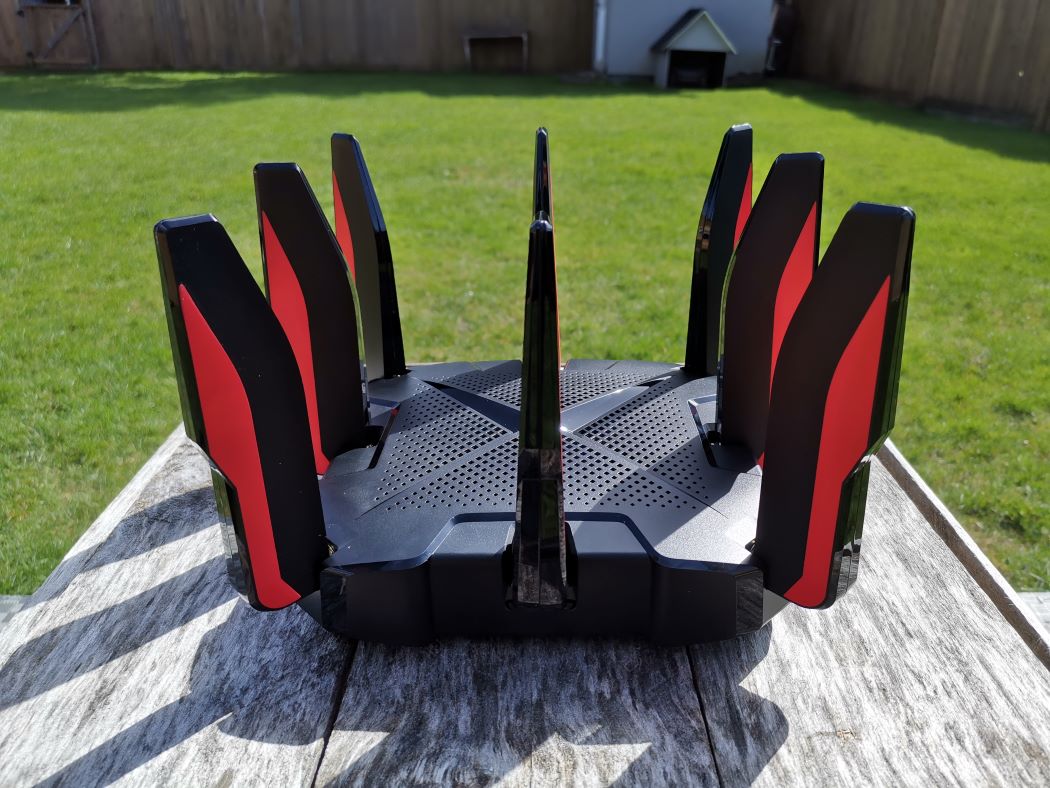
One of the best investments any family can make in 2021 is a new router. With the release of the new Wi-Fi 6 standard, investing in a new router can future-proof your Wi-Fi network for the next generation of Wi-Fi 6 devices.
Today I’m reviewing the new TP-Link Archer GX-90 AX6600 router. It’s a Wi-Fi 6 router designed for gaming. With a dedicated 5GHz band for gaming, dual WAN ports, and Game Accelerator, this router appeals to dedicated gamers looking to upgrade to Wi-Fi 6.
Design of the TP-Link Archer GX-90 router
At first glance, you might have mistaken this router for a toy spider. From its appearance, you can tell this router means business. The distinguishing feature is the eight, removable high-gain antennas. Unlike some routers, the antennas are not adjustable. Once installed, they sit in a fixed position.
Under the hood, you’ll find a 1.5GHz quad-core processor. This ensures fast transmission speeds and ensures that all the devices and applications run smoothly without a hitch.
In most cases, the Archer GX-90 will sit on a table or shelf. The bottom features screw slots to mount it to a wall.

Port options
The Archer GX-90 features a 2.5 Gbps WAN/LAN port, a 1 Gbps WAN/Lan port, three Gigabit LAN ports, and both a USB 3.0 and 2.0 port.
It should be noted that this is a dual WAN router. It can be used to connect two Internet connections, one at 2.5 Gbps and another at 1 Gbps. . For competitive gamers, this is a killer feature because it allows two different ISP connections at the same time. This provides load balancing between gaming and other Internet activity to achieve the best possible connection. Furthermore, it can also act as a backup in the event one network goes down.
The LAN ports can be used for a wired connection to gaming consoles, smart TVs, and computers. The USB ports can be used to connect external hard drives and printers to the network.

Wireless Speeds with the GX-90
A lot of people are confused about the naming convention of routers, and how they relate to the wireless speeds. The Archer GX-90 is an AX6600 Triband Wi-Fi 6 router. The AX tells us that it is a Wi-Fi 6 router. The 6600 tells us that the combined speeds of all three bands equal 6600Mbps.
The speeds are 1201 Mbps on the first 5GHz band, 4804 Mbps on the second 5GHz band, and 574 Mbps on the 2.4 GHz band. If you add those three up (1201 + 4804 + 574 Mbps) you get 6600 Mbps.
With speeds up to 4804 Mbps, the second 5GHz band is dedicated to gaming. Combined with a dedicated 2.5 Gbps WAN, this creates a killer game streaming networking setup.
The important thing to remember is the words “up to”. Actual wireless throughput will vary. It all depends on the network conditions and environmental variables such as building material, the density of traffic, and the location of the gaming device. If you can, always opt for a wired connection to get the best throughput possible.
Setting up the TP-Link Archer GX-90 router
Getting the Archer GX-90 router setup was a breeze. As stated in the Quick Start Guide, I downloaded the TP-Link Tether app and followed the instructions. You will need to create a TP-Link ID. Once the router is set up, it will bind your device to the TP-Link ID. This is a fantastic security feature to prevent unauthorized access to your router and home network.
In all the setup took less than 10 minutes. The app interface is nicely organized and easy to navigate. The Parental Controls were simple to set up. Parents who are not tech experts should have no problem blocking off the Internet at certain times (i.e bedtime) and particular websites from particular devices.
Wireless signal strength
One of the big advantages of Wi-Fi 6 is allocating Wi-Fi bandwidth to more devices and increase load capacity. Another advantage is increasing signal coverage with additional networking equipment. The GX-90 supports TP-Link OneMesh which allows users to add additional networking equipment to create a mesh network. This is a great option if users want to extend their network range (i.e. onto a backyard deck).
Indoors I received an 85% signal strength on the 5GHz band in my home studio. However, the signal strength decreased to 60% as I went onto my backyard deck. I was unable to get a signal from my backyard shed. This was the farthest distance from the router on my property. With an additional product such as the TP-Link Wireless AX1500 Dual-Band Wi-Fi 6 Range Extender, I should be able to get a signal to my shed.
In the future, I would love to test a Wi-Fi 6 router with a compatible Wi-Fi 6 extender to bring Wi-Fi to my backyard shed. In all the years of testing Wi-Fi routers, I’ve never been able to get a strong signal there. That would bring tangible proof of the benefits Wi-Fi 6 offers to homeowners.
Game Center
One thing missing in the app was gaming information and data. Game Accelerator was the only game-related section highlighted in the app. As this is a new device, I suspect a future app update will resolve this. Instead, I logged into the router on my laptop and found the Game Center Tab.
Here you will find real-time network traffic information along with performance metrics such as CPU Load and Memory Usage. Also on the Game Center Dashboard is Device Priority. Here I selected device priority to my PS4 console by clicking on a simple switch next to the listed device.
Game Accelerator is also featured in Game Center and it can be turned on or off. With it on, Game Accelerator reduces game latency and boost game speed. From what I can tell, it does this by prioritizing gaming streams over everything else when toggled on.
Game Diagnostics can troubleshoot network connectivity problems. It uses two diagnostic tools, Ping and Traceroute. I used Ping and entered my laptop’s IP address. It sent a ping and provided a round-trip minimum, average, and max speeds in milliseconds. For gamers experiencing connectivity problems, this is an easy way to diagnose connectivity problems.

Final thoughts
With the popularity of online gaming, it’s no wonder that TP-Link is introducing a Wi-Fi 6 router dedicated to gaming. The person buying the Archer GX-90 identifies themselves as a serious, perhaps semi-professional gamer. A dedicated WAN and wireless 5GHz band just for gaming is the ultimate networking setup for online gaming. Still, it would always be advisable to connect to the router through a wired LAN port to ensure the best possible connection to the Internet.
With the Archer GX-90, TP-Link put the most effort into the Game Center interface to position this as a gaming router. I do like the overall look, but they should have added some cool RGB lights to the router design. It may function well as a gaming router, but having some cool lights would make it a feature in any gaming room. Gamers love gear, especially when it has RGB lights. TP-Link totally missed a great opportunity there.
What I do know is that gamers want the best gear possible and getting the latest networking equipment is no exception. If your a hardcore gamer and want to upgrade to a Wi-Fi 6 router, the TP-Link Archer GX-90 (AX6600) router is something worth considering.



